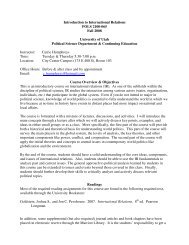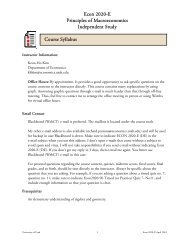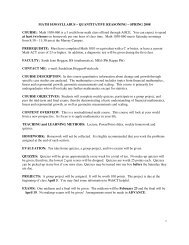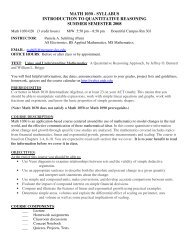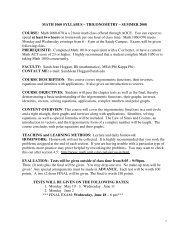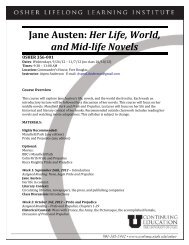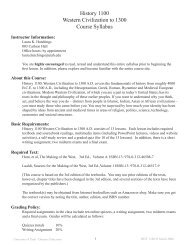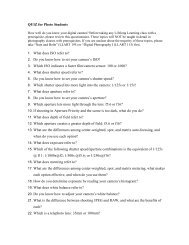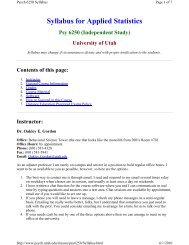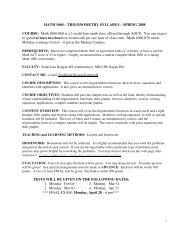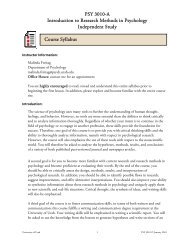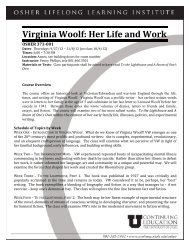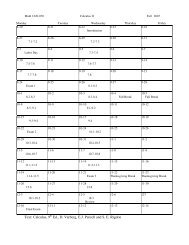Psychology 3215-B Development in Infancy & Early Childhood ...
Psychology 3215-B Development in Infancy & Early Childhood ...
Psychology 3215-B Development in Infancy & Early Childhood ...
Create successful ePaper yourself
Turn your PDF publications into a flip-book with our unique Google optimized e-Paper software.
<strong>Psychology</strong> <strong>3215</strong>-B <strong>Development</strong> <strong>in</strong> <strong>Infancy</strong> & <strong>Early</strong> <strong>Childhood</strong><br />
Distance Education<br />
Course Syllabus<br />
Instructor Information:<br />
Professor: Ilse DeKoeyer-Laros<br />
Department of <strong>Psychology</strong><br />
ilse.dekoeyerlaros@utah.edu<br />
Phone: (801) 581-2233<br />
Office Hours: Office hours will be set by appo<strong>in</strong>tment. Also please feel free to ask questions<br />
via email and I will try and get back to you <strong>in</strong> a timely manner. My email address and phone<br />
number are listed on the top of this syllabus; however, I would prefer be<strong>in</strong>g contacted via e-mail.<br />
You are encouraged to read, reread and understand this entire syllabus prior to beg<strong>in</strong>n<strong>in</strong>g the<br />
first lesson. In addition, please explore and become familiar with the entire course site.<br />
Course Overview:<br />
This class offers an <strong>in</strong>-depth exam<strong>in</strong>ation of development through the prenatal period, <strong>in</strong>fancy,<br />
and early childhood. This will be done from different perspectives, <strong>in</strong>clud<strong>in</strong>g theory, research,<br />
and first-person experience. We will consider different aspects of development (physical,<br />
cognitive, social, and emotional) and various contexts of development (<strong>in</strong>cl., family, community,<br />
and culture). The experiential world of <strong>in</strong>fants and young children is much more def<strong>in</strong>ed by<br />
their direct bodily experiences, emotions, and relationships than for us as adults. In order to<br />
understand what it may be like to be <strong>in</strong> an <strong>in</strong>fant’s or young child’s state of m<strong>in</strong>d, you will be<br />
asked to engage <strong>in</strong> experiential exercises that mimic young children’s experiences (see Fogel, p.<br />
xxiv-xxv and throughout the book).<br />
In short the objectives for this course are:<br />
1. Acquire knowledge about development and growth from the prenatal period through<br />
<strong>in</strong>fancy and early childhood that is based on theory, research, and experiential<br />
assignments.<br />
2. Appreciate how development is embedded with<strong>in</strong> physical, social and cultural<br />
environments.<br />
3. Develop skills <strong>in</strong> written expression through papers and essay assignments.<br />
4. Explor<strong>in</strong>g a fist-person experience of what it may be like to be an <strong>in</strong>fant or young child,<br />
by engag<strong>in</strong>g <strong>in</strong> experiential exercises.<br />
University of Utah 1<br />
Psych <strong>3215</strong> © Nov 2010
Psych <strong>3215</strong><br />
Course Syllabus<br />
Required Read<strong>in</strong>gs:<br />
TEXT:<br />
1. Fogel, A. (2009). <strong>Infancy</strong>: Infant, Family, and Society (5 th Edition). Sloan Publish<strong>in</strong>g (see<br />
http://www.sloanpublish<strong>in</strong>g.com/chronological_<strong>in</strong>fant_development). ISBN 978-1-<br />
59738-016-4<br />
2. Chapter 9: <strong>Early</strong> <strong>Childhood</strong> Thought, from Cole, M., Cole, S.R., & Lightfoot, C.<br />
(2005, 5 th Edition), The <strong>Development</strong> of Children. New York, Worth Publishers. (posted<br />
on E-Reserve)<br />
3. Chapter 10: <strong>Early</strong> <strong>Childhood</strong>: Psychosocial <strong>Development</strong>, from Berger, K.S. (2009), The<br />
Develop<strong>in</strong>g Person through childhood and adolescence, 8 th ed.). Worth Publishers. (posted<br />
on E-Reserve)<br />
This textbook may be obta<strong>in</strong>ed from the textbook publisher (see above), or other onl<strong>in</strong>e retailers<br />
such as Amazon (http://www.amazon.com).<br />
E-Reserve: Students can access course reserves by select<strong>in</strong>g the course reserves tab <strong>in</strong> the<br />
Marriott Library catalog, http://search.library.utah.edu. When a student is off campus, log on to<br />
Course Reserves through the student portal https://gate.acs.utah.edu and click on Library<br />
Research Tools.<br />
ADDITIONAL REQUIRED MATERIALS:<br />
1. Audio files (Located <strong>in</strong> each lesson): These audio files (<strong>in</strong> MP3) conta<strong>in</strong> the experiential<br />
exercises that you will be asked to do several times over the duration of the course.<br />
2. Video clips of developmental concepts and issues will be available through YouTube<br />
l<strong>in</strong>ks (posted <strong>in</strong> each lesson) but mostly via Worth Publisher’s Video Tool Kit that<br />
belongs to the text by Berger, The Develop<strong>in</strong>g Person Through <strong>Childhood</strong> & Adolescence 8e.<br />
The stand-alone version of the Video Toolkit costs $18.95 if purchased onl<strong>in</strong>e. To<br />
purchase access:<br />
a. Go to http://www.worthpublishers.com/devTK<br />
b. Under “Don’t have an account?,” click “Purchase Access.”<br />
c. A new w<strong>in</strong>dow will display on screen. Follow the prompts and fill <strong>in</strong> the requested<br />
<strong>in</strong>formation. Then, click “Next.”<br />
d. Enter an email address and password, and register for a specific class as described <strong>in</strong><br />
the Activation Code <strong>in</strong>structions above.<br />
e. Enter payment <strong>in</strong>formation <strong>in</strong>clud<strong>in</strong>g your name (as it appears on your credit card),<br />
credit card number, expiration date, and bill<strong>in</strong>g address. Click “Next.” After<br />
confirm<strong>in</strong>g your <strong>in</strong>formation, click “Place Your Order.”<br />
f. Once the system has confirmed payment, a thank you screen will display that<br />
confirms your name, email address, username, and password. You will also receive a<br />
confirmation email.<br />
g. Once you have successfully set up your account, you will use your email address and<br />
password to log <strong>in</strong> to the site. At any time, you can click “Update Profile” at the top<br />
of the screen to change your password or Email notification preferences.<br />
University of Utah 2<br />
Psych <strong>3215</strong> © Nov 2010
Psych <strong>3215</strong><br />
Course Syllabus<br />
If you experience difficulties with this registration process, please call Worth’s toll-free technical support<br />
number (800) 936-6899. You may also reach them via e-mail: techsupport@bfwpub.com<br />
Before you can beg<strong>in</strong> your lessons you must first pass the Introduction Quiz. This quiz is<br />
designed to help you understand important <strong>in</strong>formation regard<strong>in</strong>g the course. The quiz will refer<br />
to material located <strong>in</strong> the syllabus and pages located <strong>in</strong> the Start Here folder <strong>in</strong> Blackboard. Feel<br />
free to use these references while tak<strong>in</strong>g the quiz. You must pass the quiz with a 100% <strong>in</strong><br />
order to open your lessons. You may take it as many times as needed. The quiz will not<br />
count towards your grade.<br />
Grad<strong>in</strong>g/Assignments:<br />
The assignments <strong>in</strong> this class are mostly written assignments <strong>in</strong> which you can show your<br />
understand<strong>in</strong>g of the course materials by provid<strong>in</strong>g.<br />
Assignment Po<strong>in</strong>ts Due<br />
11 out of 13 study questions 11 x 20 = 220 After each lesson<br />
2 essay exams 2 x 200 = 400 Exam 1: after lesson 7<br />
Exam 2: after lesson 13<br />
1 Paper 300 After lesson 10<br />
4 experiential exercises 4 x 20 = 80 After lessons 3, 6, 8, and 12<br />
Total 1000<br />
A 93-100 C 73-76<br />
A- 90-92 C- 70-72<br />
B+ 87-89 D+ 67-69<br />
B 83-86 D 63-66<br />
B- 80-82 D- 60-62<br />
C+ 77-79 E 59 and below<br />
STUDY QUESTIONS:<br />
For 11 out of the 13 lessons, you will need to answer a short essay question about the materials<br />
studied <strong>in</strong> that lesson (assigned read<strong>in</strong>gs, PowerPo<strong>in</strong>t lecture, and videos). Your answer will need<br />
to be about 1/2 to 1 page long (s<strong>in</strong>gle-spaced). For every lesson, you will be able to choose<br />
between several essay questions.<br />
EXPERIENTIAL EXERCISES:<br />
<br />
Four times over the course of this class, you will be asked to engage <strong>in</strong> an experiential exercise<br />
related to <strong>in</strong>fant and early childhood development. Instructions are <strong>in</strong> MP3 format (available<br />
<strong>in</strong> the lessons) and you may listen to them via your computer or other compatible device.<br />
There are several to choose from for each time they are due. These exercises are narrated by<br />
Ryan Nagy, MA, a certified Feldenkrais practitioner.<br />
University of Utah 3<br />
Psych <strong>3215</strong> © Nov 2010
Psych <strong>3215</strong><br />
Course Syllabus<br />
<br />
<br />
<br />
<br />
<br />
<br />
These activities are best done at a quiet location with no distractions, where you can relax<br />
and focus on the assignment. Please wear comfortable clothes <strong>in</strong> which you can move freely.<br />
Most of these exercises are done ly<strong>in</strong>g down on your back, preferably on the floor (on a<br />
blanket, towel, or yoga mat). Each exploration will last between 20 and 50 m<strong>in</strong>utes.<br />
IMPORTANT: always consider your own level of comfort and physical needs as you are<br />
do<strong>in</strong>g these exercises. If you have some physical condition that would prevent you from<br />
do<strong>in</strong>g these lessons, or if experience discomfort or pa<strong>in</strong>, please contact the <strong>in</strong>structor.<br />
After do<strong>in</strong>g each experiential lesson, you will write field notes on your experiences dur<strong>in</strong>g the<br />
experiential lessons lesson and then submit them via the Assignments tool. Your answers are<br />
only read by the <strong>in</strong>structor and are confidential so please be open and honest about your<br />
experiences, both positive and negative. Instructions <strong>in</strong>clude:<br />
Describe the sensations, movements, thoughts and emotions – or lack thereof – that occurred<br />
to you dur<strong>in</strong>g the lesson. Report on any awareness you might have about prenatal, <strong>in</strong>fant, or<br />
early childhood learn<strong>in</strong>g. Your description should have sufficient detail so that the reader can<br />
re-construct what you did dur<strong>in</strong>g the lesson.<br />
Describe some potential mean<strong>in</strong>gs of this lesson. Each lesson carries different mean<strong>in</strong>gs and<br />
different significances to participants – even to the same participant at different po<strong>in</strong>ts <strong>in</strong><br />
time. Such th<strong>in</strong>gs as current mood, life history and attitude, can affect your experience. How<br />
you were affected (or not) by the lesson? What factors could have <strong>in</strong>fluenced your response?<br />
Which of those factors are <strong>in</strong> your control and can be changed? Who might benefit (or not)<br />
from a lesson such as this?<br />
Further explorations outside of class may give you additional <strong>in</strong>sights <strong>in</strong>to developmental<br />
processes. Thus, they are recommended, but not required. Additional lessons can be found at<br />
the end of most chapters <strong>in</strong> the textbook (“Awareness through Movement” sections). The<br />
more you practice, the more aware you may become aware of yourself and the process of<br />
learn<strong>in</strong>g experientially.<br />
NOTE: It is required that each assignment be submitted through the Blackboard assignment<br />
tool. Assignments not submitted correctly will not be accepted. In addition, all assignments<br />
are to be <strong>in</strong> Word format ( .doc or .docx) or an .rtf file if us<strong>in</strong>g other word process<strong>in</strong>g<br />
software (other format types will not be accepted unless prior arrangements with the<br />
<strong>in</strong>structor have been made).<br />
PAPER:<br />
The paper will be a case study on a question of your choice, related to development <strong>in</strong> the<br />
prenatal, <strong>in</strong>fancy, or early childhood periods. This case study can be about an <strong>in</strong>fant or young<br />
child that you know (ages 0 to 6 years), about your own <strong>in</strong>fancy or early childhood, or about the<br />
prenatal period. Examples of topics are attachment, temperament, day care, development of a<br />
sense of self, cognitive development, TV, etc. You will be required to do an <strong>in</strong>terview (e.g., with<br />
your parent(s) and/or sibl<strong>in</strong>gs; with a parent of a young child, with a pregnant woman) or an<br />
observation (e.g., of an <strong>in</strong>fant or young child; of a daycare center). Integrate materials from class<br />
and at least two additional research articles with your f<strong>in</strong>d<strong>in</strong>gs. The paper should be between 3<br />
and 6 pages long (s<strong>in</strong>gle-spaced to save paper), <strong>in</strong>clud<strong>in</strong>g references. You can f<strong>in</strong>d more detailed<br />
University of Utah 4<br />
Psych <strong>3215</strong> © Nov 2010
Psych <strong>3215</strong><br />
Course Syllabus<br />
<strong>in</strong>structions at the end of lesson 10. Submit this assignment us<strong>in</strong>g Turnit<strong>in</strong> located on the course<br />
homepage labeled as “Paper.”<br />
Academic Honesty: Do not copy from the book or other read<strong>in</strong>gs! If there is a long section<br />
from the book or any other read<strong>in</strong>g, please paraphrase it (i.e., use your own words). Short quotes<br />
are f<strong>in</strong>e, as long as quoted and referenced with the authors, year, and page number. Literal<br />
copy<strong>in</strong>g of materials without proper referenc<strong>in</strong>g will be treated as plagiarism. See U of U Code<br />
of Student Rights and Responsibilities (www.adm<strong>in</strong>.utah.edu/ppmanual/8/8-10.html).<br />
ESSAY EXAMS:<br />
There will be two essay exams <strong>in</strong> this class. The first will cover Lessons 1 through 7 and the<br />
second covers Lessons 8 through 13. Exam 1 will be an open-book, but it will need to be<br />
completed under supervision of a proctor. Exam 2 will be closed to books and notes. Exam<br />
questions will be very similar to the weekly study questions but they will <strong>in</strong>clude more details.<br />
Exam questions will ask for <strong>in</strong>tegration and application of the study questions. You will be able<br />
to answer two out of four possible essay questions on each exam. Each question will<br />
consist of several sub questions.<br />
Note: As this course is offered <strong>in</strong> an onl<strong>in</strong>e format, exams will be proctored through<br />
Distance Education. Go to the Exam Request l<strong>in</strong>k located <strong>in</strong> the Start Here folder to<br />
understand how to make arrangements for proctored exams. You must pass the f<strong>in</strong>al exam<br />
<strong>in</strong> order to pass the course. If you fail the f<strong>in</strong>al exam you will fail the course. This is a<br />
requirement of all U of U Distance Education courses.<br />
Plann<strong>in</strong>g Time:<br />
Successful students (those that get A’s, B’s, and C’s) use their time wisely. Just like a face-to-face<br />
course, the standard formula for college coursework is that for every one hour of class time will<br />
result <strong>in</strong> three to six hours (and sometimes more) of homework; so a three-unit course will<br />
require an average of 9 or more hours of homework (read<strong>in</strong>g, research, study<strong>in</strong>g) per lesson. As a<br />
result, successful students plan their time wisely so that they keep up with assignments by<br />
ma<strong>in</strong>ta<strong>in</strong><strong>in</strong>g a pace that fits the course schedule. They also communicate with the <strong>in</strong>structor<br />
often so that they can receive much needed feedback on their work.<br />
Onl<strong>in</strong>e Course Responsibilities:<br />
This course requires significant self-motivation. Some lessons take a considerable amount of time<br />
to complete. Please note that not all lessons are created equal. Some may take a bit more time<br />
than others. Some students believe this to be a much easier way to study this subject than <strong>in</strong> the<br />
on-campus frame work. Others may feel very <strong>in</strong>timidated at first. Be patient as you work your<br />
way through the first few lessons. If you are serious about the material, you will learn as much, if<br />
not more, than most on-campus students about this subject and develop read<strong>in</strong>g and<br />
communication skills that are vital to the workforce of the 21st century.<br />
The follow<strong>in</strong>g is a list of general notes as they relate to the course:<br />
University of Utah 5<br />
Psych <strong>3215</strong> © Nov 2010
Psych <strong>3215</strong><br />
Course Syllabus<br />
<br />
<br />
All course communication with the <strong>in</strong>structor should be completed us<strong>in</strong>g the <strong>in</strong>structors<br />
email address listed on the first page of this syllabus.<br />
Assignments are to be submitted <strong>in</strong> Word format ( .doc or .docx) or an .rtf file if us<strong>in</strong>g<br />
other word process<strong>in</strong>g software.<br />
Onl<strong>in</strong>e Courtesy & Communication Policy:<br />
Extreme consideration for the feel<strong>in</strong>gs of others is expected. People cannot see you smile and<br />
may not know when you are jok<strong>in</strong>g. Do not tell people they are stupid or wrong. Do expla<strong>in</strong><br />
why you believe differently. If someone has the facts wrong, direct them to the source of<br />
accurate <strong>in</strong>formation or politely offer your alternative “facts.” Use of profanity or direct/<strong>in</strong>direct<br />
<strong>in</strong>sults which defame a person’s character, race, ethnicity, religion, etc. are <strong>in</strong>appropriate and will<br />
not be tolerated.<br />
Academic Dishonesty & Plagiarism:<br />
Cheat<strong>in</strong>g will not be tolerated <strong>in</strong> this course. Anyone caught cheat<strong>in</strong>g will fail the course and<br />
will be reported to the Associate Vice President for Academic Affairs, <strong>in</strong> accordance with the<br />
Code of Student Rights and Responsibilities.<br />
Successful students always make sure that their work is orig<strong>in</strong>al. This is important because the<br />
<strong>in</strong>structor must be able to gauge what the student has learned. Therefore, copy<strong>in</strong>g the work of<br />
another person, whether an essay, answers on your assignments or dur<strong>in</strong>g a test, is considered<br />
plagiarism.<br />
Plagiarism is a form of cheat<strong>in</strong>g. Any time a student uses someone else’s work and does not give<br />
that person credit, it is plagiarism. Anyone who plagiarizes will receive a fail<strong>in</strong>g grade on the<br />
assignment. If this is repeated, the student will fail the course and can be expelled from the<br />
university. If you are “suspected” of plagiarism, you will bear the burden of proof. You must be<br />
able to present rough drafts or related materials and discuss the topic <strong>in</strong>telligently. Refer to the<br />
University of Utah Plagiarism Policy for more details and/or the University of Utah - Policy and<br />
Procedures Manual.<br />
General Information:<br />
The University of Utah seeks to provide equal access to its programs, services and activities for<br />
people with disabilities. If you will need accommodations <strong>in</strong> this class, reasonable prior notice<br />
needs to be given to the <strong>in</strong>structor and to the Center for Disability Services,<br />
http://disability.utah.edu/ 162 Olp<strong>in</strong> Union Build<strong>in</strong>g, 581–5020 (V/TDD) to make<br />
arrangements for accommodations. This <strong>in</strong>formation is available <strong>in</strong> alternative format with prior<br />
notification. Please provide the <strong>in</strong>structor with a letter from the Center for Disability Services as<br />
soon as possible.<br />
All written <strong>in</strong>formation <strong>in</strong> this course can be made available <strong>in</strong> alternative format with prior<br />
notification to the Center for Disabilities.<br />
University of Utah 6<br />
Psych <strong>3215</strong> © Nov 2010
Psych <strong>3215</strong><br />
Course Syllabus<br />
THE INSTRUCTOR RESERVES THE RIGHT TO CHANGE/MODIFY<br />
THE CONTENTS OF THIS SYLLABUS<br />
COPYRIGHT NOTIFICATION<br />
Copyright notice to students tak<strong>in</strong>g onl<strong>in</strong>e courses:<br />
Notice to students that materials used <strong>in</strong> connection with the course may be subject to copyright<br />
protection.<br />
TEACH Act Copyright Notice<br />
The materials on this course Web site are only for the use of students enrolled <strong>in</strong> this course for<br />
purposes associated with this course and may not be reta<strong>in</strong>ed or further dissem<strong>in</strong>ated.<br />
University of Utah 7<br />
Psych <strong>3215</strong> © Nov 2010



